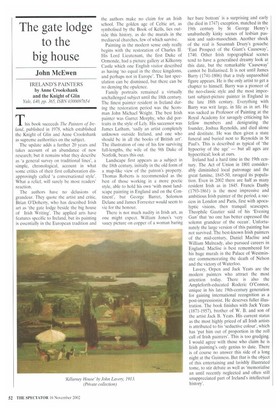The gate lodge to the big house
John McEwen
IRELAND'S PAINTERS by Anne Crookshank and the Knight of Glin Yale, £40, pp. 365, ISBN 0300097654 This book succeeds The Painters of Ireland, published in 1978, which established the Knight of Glin and Anne Crookshank as supreme authorities on the subject.
The update adds a further 20 years and takes account of an abundance of new research; but it remains what they describe as 'a general survey on traditional lines', a simple, chronological, account in what some critics of their first collaboration disapprovingly called 'a conversational style'. What a relief, will surely be most readers' reaction.
The authors have no delusions of grandeur. They quote the artist and critic, Brian O'Doherty, who has described Irish art as 'the gate lodge beside the big house of Irish Writing'. The applied arts have features specific to Ireland, but its painting is essentially in the European tradition and the authors make no claim for an Irish school. The golden age of Celtic art, as symbolised by the Book of Kells, lies outside this history, as do the murals in the mediaeval churches, few of which survive.
Painting in the modern sense only really begins with the restoration of Charles II. His Lord Lieutenant, the first Duke of Ormonde, had a picture gallery at Kilkenny Castle which one English visitor described as having no equal in the three kingdoms, and perhaps not in Europe'. The last speculation can be dismissed, but there can be no denying the opulence.
Family portraits remained a virtually unchallenged subject until the 18th century. The finest painter resident in Ireland during the restoration period was the Scotsman John Michael Wright. The best Irish painter was Garret Morphy, who did portraits in the style of Lely. His successor was James Latham, 'sadly an artist completely unknown outside Ireland, and one who should be in all the books of British art'. The illustration of one of his few surviving full-lengths, the wife of the 9th Duke of Norfolk, bears this out.
Landscape first appears as a subject in the 18th century, initially in the old form of a map-like view of the patron's property. Thomas Roberts is recommended as the best of those working in a more poetic style, able to hold his own 'with most landscape painting in England and on the Continent', but George Barret, Solomon Delane and James Forrester would seem to vie for the honour.
There is not much nudity in Irish art, as one might expect. William Jones's 'very saucy picture on copper of a woman baring her bare bottom' is a surprising and early (he died in 1747) exception, matched in the 19th century by St George Henry's unabashedly kinky scenes of lesbian passion and sado-masochism. Another shock of the real is Susannah Drury's gouache 'East Prospect of the Giant's Causeway', 1740. Other Irish topographical scenes tend to have a generalised dreamy look at this date, but the remarkable 'Causeway' cannot be Italianised. It is not until James Barry (1741-1806) that a truly unparochial figure appears. He is the only artist to get a chapter to himself. Barry was a pioneer of the neo-classic style and the most important subject-picture painter in England in the late 18th century. Everything with Barry was writ large, in life as in art. He was sacked as Professor of Painting at the Royal Academy for savagely criticising his fellow members and denigrating the founder, Joshua Reynolds, and died alone and destitute. He was then given a state funeral and buried next to Reynolds in St Paul's. This is described as typical of 'the hypocrisy of the age' — but all ages are hypocritical; look at ours.
Ireland had a hard time in the 19th century. The Act of Union in 1801 considerably diminished local patronage and the great famine, 1845-50, ravaged its population. Even in 2002 there are half as many resident Irish as in 1845. Francis Danby (1793-1861) is the most impressive and ambitious Irish painter of the period, a success in London and Paris, first with apocalyptic visions, then tranquil seascapes. Theophile Gautier said of his 'Evening Gun' that 'no one has better expressed the solemn grandeur of the ocean'. Unfortunately the large version of this painting has not survived. The best-known Irish painters of the mid-century, Daniel Maclise and William Mulready, also pursued careers in England. Maclise is best remembered for his huge murals in the Palace of Westminster commemorating the death of Nelson and the victory of Waterloo.
Lavery, Orpen and Jack Yeats are the modern painters who attract the most attention today. There is also the Ampleforth-educated Roderic O'Connor, unique in his late 19th-century generation for gaining international recognition as a post-impressionist. He deserves fuller illustration. The book finishes with Jack Yeats (1871-1957), brother of W. B. and son of the artist Jack B. Yeats. His current status as the most highly priced of all Irish artists is attributed to his 'seductive colour', which has 'put him out of proportion in the roll call of Irish painters'. This is too grudging. I would agree with those who claim he is Irish painting's only genius to date. There is of course no answer this side of a long night at the Guinness. But that is the object of this entertaining and lavishly illustrated tome, to stir debate as well as 'memorialise an until recently neglected and often still unappreciated part of Ireland's intellectual history'.


























































































 Previous page
Previous page